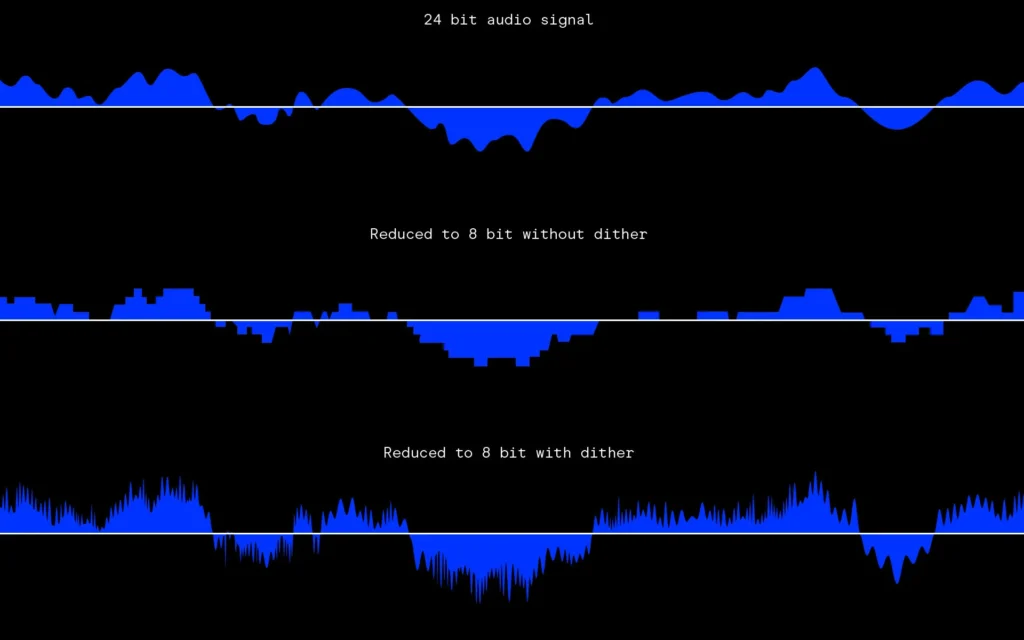Understand what is dithering? get detailed explanations at TutorialKart.com. Learn how this technique reduces visual and audio imperfections by adding noise to smooth transitions in images, sounds, and 2D/3D graphics. With step-by-step guides, examples, and clear definitions, TutorialKart helps you grasp the importance and application of dithering in digital media, ensuring a better understanding of this essential process in modern technology.
Dithering is a process used in digital imaging, computer graphics, and audio processing to reduce the appearance of low-quality artifacts that result from converting data from high quality to low quality formats. By applying random noise to an image or sound, dithering smooths out transitions between tones or colors. This method helps reduce the appearance of banding (abrupt transitions between levels of color or sound), creating a more natural-looking output or sound.
For instance, when downsampling a digital image from millions of colors to 256, the image loses its smooth gradients. Dithering comes into play by scattering pixels in such a way that creates a smoother transition between colors.
What is Dithering in Digital Imaging?
In digital imaging, dithering is important when converting high-color images into formats with lower color depths. This is particularly useful for GIFs or indexed images where the color palette is limited. Dithering tricks the eye into perceiving smooth color transitions by scattering pixels of various colors.
For example, when trying to display a sky gradient on a 256-color monitor, without dithering, the color transitions would appear as harsh lines. With dithering, these transitions appear smoother because the pixels blend together to create the illusion of a wider palette.
Dithering in Audio Processing
In audio processing, dithering is used when reducing the bit depth of audio, such as converting from 24-bit to 16-bit. Quantization errors can introduce distortion during the conversion, but dithering minimizes these errors by adding low-level noise to the audio. This results in a smoother final output that closely resembles the original sound.
For example, when converting a 24-bit studio-quality recording to a 16-bit CD format, dithering is used to reduce the noise and maintain audio quality.

Dithering in 2D and 3D Graphics
In both 2D and 3D graphics, dithering is used to improve the appearance of rendered scenes when color depth or resolution is limited. In 2D graphics, dithering helps smooth out textures, gradients, and shadows, making the visuals appear less jagged, even with limited colors.
For example, in older video games with restricted color palettes, dithering allowed artists to create complex textures and smooth gradients, making the visuals appear more detailed than the hardware typically allowed. Even with modern displays that support millions of colors, dithering is still useful in texturing when performance might affect color accuracy.
In 3D graphics, dithering helps render complex lighting effects and soft shadows. When a 3D model or environment has gradients or shadows, dithering spreads the color values to create a more realistic appearance. This ensures that strong color transitions don’t disrupt the realism of the scene.
For instance, in ray tracing or when rendering soft shadows, dithering smooths out transitions between light and dark tones, even when the renderer or display cannot fully reproduce all color depths.
Conclusion
Dithering plays an essential role across various media, including digital imaging, audio processing, and 2D/3D graphics. By adding controlled noise, dithering improves the overall quality of the output by masking imperfections and creating smoother transitions. Whether you’re viewing images, listening to music, or playing a video game, dithering enhances the experience by compensating for limitations in color or sound depth.
In short, dithering is a straightforward yet powerful technique for maintaining quality when reducing data fidelity, making it an indispensable tool in today’s digital world.
